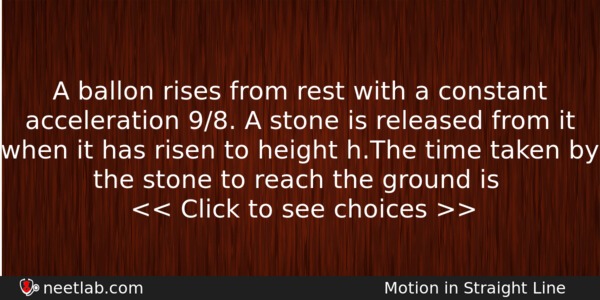| ⇦ | 
| ⇨ |
A ballon rises from rest with a constant acceleration g/8. A stone is released from it when it has risen to height h.The time taken by the stone to reach the ground is
Options
(a) 4√(h/g)
(b) 2√(h/g)
(c) √(2h/g)
(d) √(g/h)
Correct Answer:
2√(h/g)
Explanation:
No explanation available. Be the first to write the explanation for this question by commenting below.
Related Questions: - The molar specific heats of an ideal gas at constant pressure and volume are denoted
- The electirc field in a certain region is acting radially outward and is given by E=Ar.
- A metal plate weighing 750g is to be electroplated with 0.05% of its weight of silver.
- Young’s modulus of the material of a wire is 18×10¹¹ dyne cm⁻².its value in SI is
- When indensity of radiation is increased on a photosensitive plate, then
Question Type: A
(1)
Difficulty Level: Medium
(3)
Topics: Motion in Straight Line
(93)
Subject: Physics
(2479)
Important MCQs Based on Medical Entrance Examinations To Improve Your NEET Score
- The molar specific heats of an ideal gas at constant pressure and volume are denoted
- The electirc field in a certain region is acting radially outward and is given by E=Ar.
- A metal plate weighing 750g is to be electroplated with 0.05% of its weight of silver.
- Young’s modulus of the material of a wire is 18×10¹¹ dyne cm⁻².its value in SI is
- When indensity of radiation is increased on a photosensitive plate, then
Question Type: A (1)
Difficulty Level: Medium (3)
Topics: Motion in Straight Line (93)
Subject: Physics (2479)
Important MCQs Based on Medical Entrance Examinations To Improve Your NEET Score
18000+ students are using NEETLab to improve their score. What about you?
Solve Previous Year MCQs, Mock Tests, Topicwise Practice Tests, Identify Weak Topics, Formula Flash cards and much more is available in NEETLab Android App to improve your NEET score.
Share this page with your friends

The velocity of the balloon at the height h is
v = √(2ah) = √(2gh/8) = √(gh)/2
Initial velocity of the stone at height h is u = √(gh)/2 upwards
h = ut + gt²/2
put the value of u in the above relation and rearrange the terms to obtain,
(√(gH)/2 )t + gt²/2 – h = 0
(√(gH))t + gt² – 2h = 0
The time taken by the stone to reach the ground can be obtained by solving the above quadratic.
t = 2√[h/g]